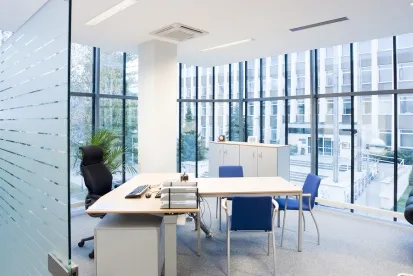The Shelter-in-Place orders issued by various state and local jurisdictions are being modified to allow businesses, other than just “Essential Businesses,” to open and operate. Although commercial office buildings have been allowed to remain open to serve Essential Businesses and to allow their tenants to perform "Essential Activities," the coming expansion of allowed businesses is expected to cause a significant increase in the number of persons accessing and using these spaces. This increased usage will present a number of challenges as tenants and landlords work to provide access to space and use of commercial office premises in a manner that is both safe and in compliance with official guidelines and regulations.
Many government agencies and industry groups, including BOMA International, have issued guidance to employers and landlords regarding the processes and protocols that will be required for commercial office buildings as their tenants return to work. We recommend that you take full advantage of, and review thoroughly, these important resources, some of which are listed at the end of this outline.
An important part of a landlord's focus on these circumstances is to realize, as the basis for an appropriate approach, that responsibility for compliance with the various protocols and requirements imposed in connection with the return to the workplace, from the requirement of “social distancing” to enhanced cleaning and sanitization, will need to be allocated between landlords and their third party service providers and vendors, and tenants and their visitors. This Primer is meant to assist landlords in navigating the issues, and to move forward while implementing all appropriate practices for prudent and responsible office building owners. Obviously there is no "one-size fits all" protocol for office building owners in this circumstance. Each building stands on its own with regard to the particular measures necessary to comply with a building owner's duties during this unprecedented time and not every measure described in this Primer will be appropriate or necessary in every building. Owners should contact counsel to determine which measures are required by law, which are simply recommended as appropriate for first class office buildings and which are merely suggested options. For that reason, this Primer should be viewed as a melding of protocols that are slated to be implemented by well-known and knowledgeable industry organizations and first-class institutional office landlords.
Also, rather than trying to provide an exhaustive and detailed list of specific necessary actions (which are better covered in some of the other resources mentioned above), this Primer will instead provide additional clarity as to (i) those areas that are a tenant's domain and (ii) those areas that are a landlord's domain, including covering actions that landlords should not take part in, with the goal to enable landlords to proceed to implement practices and protocols in a way that is optimal for a specific property. In general, landlords should not take actions that overlap with tenant responsibilities, or create unreasonable levels of liability for landlord. This Primer is most applicable to multi-tenant office buildings where a landlord has primary responsibility for the operation of the building and building common areas. In a single tenant office building, the responsibilities will shift almost entirely to the tenant as the primary user of, and employer at, the building.
1. Tenant Responsibilities
Tenants, both as employers and as the parties directly responsible for the maintenance, operation, and safety of their premises, will bear a substantial part of the responsibility of maintaining a safe and compliant office building. State and county agencies have promulgated specific recommendations and requirements that employers will be required to comply with, and in the context of a commercial office building, it will be important for the landlord to recognize where the responsibilities of the individual tenants are paramount.
-
Face Coverings. Tenants, not landlords, should be responsible for requiring that their employees, vendors, and visitors wear face coverings in a manner compliant with applicable public health orders and building rules within their tenant spaces. Depending on the specific city or county orders, face coverings may be required by law in public areas, and most, if not all landlords, are requiring face coverings be worn in all building common areas.
-
Sanitization. Tenants, not landlords, should be responsible for sanitizing their tenant premises during the workday, including frequent sanitization of door handles and other frequently touched areas within their premises. Full floor tenants’ responsibilities should also include sanitizing the elevator lobbies and restrooms on their floors. Some landlords may be causing their day porters, that otherwise provide some bathroom related services for full floor tenant spaces, to partially sanitize restrooms during the work day.
-
Hygiene Practices. Tenants should supply hand sanitizer in their premises for their visitors and employees, and encourage frequent hand washing.
-
Required Signage. Within their leased premises, tenants should post any and all signage as required or suggested by applicable authorities, including information regarding social distancing, hand washing, and face coverings.
-
Social Distancing. Tenants, not landlords, should be determining whether they will create staggered work hours, work from home rules, and other measures to ensure that the number of people in their premises at any one time does not prevent compliance with recommended social distancing measures. Landlords cannot force tenants to reduce their density levels within their tenant spaces and should not attempt to enforce social distancing within such spaces. There are many additional recommended practices that tenants may choose to implement (e.g., requiring people to wash their hands immediately upon arrival at the premises, making the hallways “one-way” to avoid people needing to pass each other in the halls, etc.).
-
Limiting Visitors. Tenants should work to limit the number of non-employees that are allowed to visit their premises. If appropriate to preserve the ability to social distance within the common areas, landlords may require that visitors be pre-registered, and informed of the required protocols for visiting the premises and the building, including the requirement to wear a face covering in the building parking areas, common areas, and elevators.
-
Premises Improvements/Alterations. Depending upon the individual circumstances of a tenant's office buildout and the frequency of visitors, tenants may consider installing plexiglass or similar partitions at reception and office service areas in the premises. Landlords should not be involved in this determination.
-
Temperature Checking. Whether to check an employee's temperature, or require that they do so themselves, raises a number of difficult questions, including compensation concerns relating to wage and hour requirements, record keeping requirements, confidentiality and privacy issues, and compliance with federal HIPAA requirements. In some jurisdictions, temperature checks are being mandated by local health authorities. Tenants will need to consult with their legal teams to determine what might be required, and what is the best solution for their particular situation. Landlords should not be involved in tenant's determination as to whether this is permissible or required in any individual situation.
2. Landlord Actions
As the managers and operators of the buildings, landlords will also have many new requirements imposed by the need to provide safe and legally compliant access and use of the common areas of the building. In general, landlord should take those actions that a reasonably prudent landlord would take in order to protect the health and safety of tenants, vendors, and visitors.
-
Systems and Protocol Modifications and Alterations. There are many modifications to building systems that can be made to reduce the number of frequently touched areas. These include things as simple as leaving doors open during building hours, or providing a door attendant to open and close doors and making the visitor check-in process “contactless” by requiring pre-registration. More involved is the installation of automatic doors, modifying elevator call and dispatch systems to be "contactless", and making alterations to building security check-in areas, parking fee payment areas, and similar customer facing locations to provide plexiglass or similar protective partitions. The appropriateness of enacting any of these modifications must be determined on a case by case basis. Each building provides a different set of circumstances and landlords need not enact modifications that are not necessary to reasonably ensure a safe and healthy premises.
-
Tenant Communications. Landlords will need to be in constant communication with their tenants regarding the new building protocols, and to coordinate access and use of the building parking areas and elevators. Landlords should work with tenants to understand tenants' staffing needs and hours of operation to help guide landlords in terms of parking and general building access and elevator operation. Tenants will need to inform landlords of any special tenant needs, such as enhanced cleaning, or premises alterations requirements. Landlords should encourage tenants to inform them of any positive cases within their premises.
-
Building Staff. Where the landlord’s own employees (e.g., in the form of a wholly owned management company) are providing services to the building, landlords will need to follow, and cause their employees to follow, all legally required protocols, including requirements related to use of face coverings, temperature checks, social distancing, and hand washing/sanitization. Where the landlord is considering its responsibilities vis-à-vis its own employees, many of the same considerations above relating to tenant responsibilities will apply to landlords.
-
Handwashing. Building staff should be required to wash their hands upon arrival at the building, and at frequent intervals during the day. The building will need to provide adequate opportunity, including times and adequately equipped sink or restroom areas, for its staff to follow these protocols.
-
Prohibit Working Sick. No building staff should be allowed at the building when sick or showing symptoms of COVID-19.
-
Minimize Sharing of Equipment. Landlords should minimize sharing of equipment, including phones and computers. Building engineers should avoid sharing tools, or ensure that tools are cleaned and disinfected if they are to be shared.
-
Temperature Checking. Whether to check your employees’ temperature, or require that they do so themselves, raises a number of difficult questions, as mentioned above under the tenant guidelines. Landlord should consult with counsel to determine whether such a measure is appropriate in the particular building circumstance.
-
-
Building Vendors. Landlord’s vendors (janitorial service companies, third-party project management teams, parking operators, etc.) should be responsible to ensure that their employees follow required protocols, including requirements related to use of face coverings, temperature checks (if appropriate), and hand washing/sanitization. Vendors must enforce these requirements and the applicable vendor contracts should be amended to reflect the same. Landlords should not directly instruct nor monitor vendor employees.
-
Handwashing; No Working Sick. Vendor employees should be required to wash their hands upon arrival at the building, and at frequent intervals during the day. The building will need to provide access to adequately supplied sink or restroom areas in order to enable its vendors' staff to follow these protocols. No vendor employee should be allowed at the building when sick or showing symptoms of COVID-19. Landlords should coordinate with their vendors to encourage vendors to make sure these measures are being implemented.
-
Access by Tenants and Visitors. One of the greatest challenges for landlords will be accommodating access to the building by the employees, staff, and visitors of their tenants in a safe manner and in compliance with applicable protocols, while minimizing the inconvenience that such protocols will inevitably entail.
-
Parking Areas. Landlords will need to ensure that their parking staff is able to work in a safe environment, including by requiring that face coverings be worn in the parking areas by parking attendants and building tenants and visitors. Landlords could, on an optional basis, modify parking fee payment areas and similar customer facing locations to provide plexiglass or similar protective partitions.
-
Valet Parking. At the moment, many building owners have elected to stop providing valet parking until they can ensure that such a service can be provided in a safe manner. This obviously creates a problem which must be addressed with tenants for buildings that need valet parking in order to preserve the necessary parking capacity for tenants and visitors as required by leases or otherwise. Some of these landlord obligations should be mitigated by the existence of appropriate lease language or the reduced level of occupancy (and parking needs) that tenants will maintain for the immediate future.
-
Lobby Access. If possible, landlords should direct traffic flow in common areas to avoid choke-points or the necessity of close passage. “One-way” traffic is preferred, which, depending on the lobby layout, may be facilitated by having designated entry-only and exit-only access.
-
Face Coverings. Landlords will likely need to require persons accessing their building lobby to wear protective face coverings. This will be a legal requirement in many jurisdictions. One method of achieving this is to have landlords place building personnel outside of the entrance to the building in order to deny access to uncovered individuals. If a visitor or tenant refuses to wear a face covering due to a disclosed or undisclosed condition, and demands entry to the building, landlords should immediately report such situations to the relevant tenant and consult legal counsel as to whether such visitor should be denied access to the building. Each case must be handled individually.
-
Elevator Access and Usage. The BOMA guidelines referenced above include recommendations for allowing safe and compliant usage of elevators, including limiting the number of people allowed in an elevator at any one time, requiring safe distancing in elevators, establishing safe distancing queuing areas, and increasing the frequency of the cleaning and sanitization of elevator cabs and call buttons. Similar protocols will need to be implemented in loading dock and freight areas. Landlords should provide distancing floor markings and prominent signage to help tenants and visitors comply with these new requirements.
-
Security Check-in. Landlords will need to establish safe distancing queuing areas for visitor security check-ins, and increase the frequency of the cleaning and sanitization of frequently touched surfaces in such areas. Landlords could, at their option, modify security desks and similar customer facing locations to provide plexiglass or similar protective partitions.
-
Hand Sanitizer Stations. Landlords should locate contactless hand sanitizer dispensers by building entrances, elevators, and other areas frequented by visitors and tenant employees.
-
Work Hours. Landlords should consider consulting with their tenants to understand their plans for work hours and workdays in order to properly plan for parking, entry and elevator access, and usage to safely maintain social distancing protocols.
-
-
Building HVAC. Landlords should have the components of the base building HVAC system that services the building common areas and the floors of the premises inspected to ensure that they are functioning properly in accordance with manufacturer specifications, and that filters are new and HVAC and water systems have been flushed.
-
Janitorial. In many circumstances, landlords will need to increase the janitorial service specifications for the building and those tenant premises serviced by the landlord during the afterhours janitorial service to include sanitization of frequently touched surfaces, and higher cleaning frequency of high-touch areas generally, including elevators, common areas, handrails, and door handles.
-
Building Amenities. Landlords will need to carefully consider whether to allow the use of building amenity areas, such as exterior patios, conference room facilities, gym or fitness facilities, and shower and locker rooms. Most likely, if a landlord decides to shut down or limit these areas, tenants will not have a problem with such actions, because tenants are going to restrict the use of common areas (e.g., kitchens, lounge areas, conference rooms, etc.) on their premises. Landlords should increase space between common area furniture, and ensure that any such furniture is cleaned on an increased basis. If such areas do not allow for the safe implementation of social distancing protocols, then they should not be reopened. Use of any such areas will need to comply with applicable legal requirements. Landlords should review and consider updating standard waivers in connection with the use of such areas.
-
Tenant Requests. Landlords will likely receive requests from tenants regarding additional services, including enhanced cleaning of tenant spaces. Landlords should strive to provide these services, provided that the landlord has the capability and the tenants understand that these services will be a tenant direct expense. Landlords should consult with their insurance and legal teams prior to acceding to extra-ordinary tenant requests, specifically including requests that relate to the use of the building common areas, such as providing ground floor screening areas for particular tenants.
-
Signage. In addition to legally required notices (which vary by jurisdiction, so check with your legal team), landlords will need to provide additional signage and wayfinding markers to inform visitors and tenants of the new protocols. These should include floor markings informing visitors of social distancing protocols, clean and understandable directional signage, and signage regarding use of elevators, including maximum occupancy of elevator cabs. For those office buildings that are able to institute “one-way” traffic in lobbies, directional signage will be important to ensure compliance. In addition to signage in lobbies, landlords will need to install signage in loading dock and other service entry areas.
-
Enforcement. Landlords are already reporting challenges in dealing with individuals that aren’t complying with face covering and physical distancing requirements. If a visitor is failing to comply, landlords should promptly engage with the tenant that the visitor is visiting. If there is a continued refusal, the landlord should consult its legal team, and may be required to deny access to the building to such individual. In the event of a claim of disability as a reason for non-compliance, the landlord should accommodate that visitor, but may need to take additional steps to ensure the safety of other visitors, tenants, and building staff. A tenant that is failing or refusing to comply might be more problematic, and in such event, a landlord should consult with its legal team to determine the proper course of action.
-
Costs. Most of the additional costs that landlords will incur in connection with preparing buildings for re-entry under shelter orders and other governmental regulation (e.g., directional and informational signage, excess janitorial costs, and excess HVAC maintenance costs) are expenses that are part of general building operating expenses and should be passed through to tenants. In any situation where landlord chooses to install plexiglass partitions, given the relative level of cost, those costs should also be considered as an operating expense of the building. Other more material items, such as significant modifications to elevator or HVAC systems, may need to be categorized as capital expenses, in which case landlords should review their leases to determine whether and how such costs can be passed through to tenants.
3. Additional Resources
Please note that industry and governmental guidance is being frequently updated, so please check for updates to the following:





 />i
/>i

